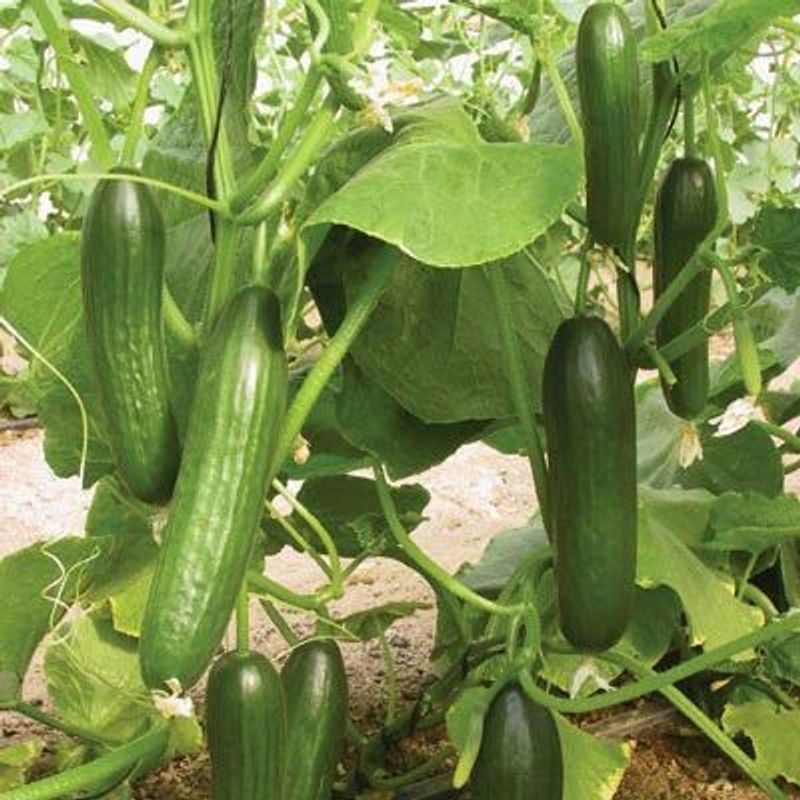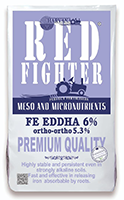Cucumber Growing Guide

There are two types of cucumber plants: vining cucumbers and bush cucumbers.
- Vining cucumbers, the most common varieties, grow on vigorous vines shaded by large leaves. The growth of these plants is fast, and the crop yield is abundant if you care for them properly. Vining varieties grow best when trained up a trellis or fence. Since they grow off the ground, the fruits will be cleaner—versus those that grow directly atop soil—often more abundant, and easier to pick.
- Bush cucumbers, however, are nicely suited to containers and small gardens.
When to Plant Cucumbers
- For an early crop, sow cucumber seeds indoors about 3 weeks before you plan to transplant them in the ground. Provide bottom heat of about 70ºF (21ºC) with a heating pad or place the seed flats on top of a refrigerator or water heater.
- Cucumber plants should be seeded outdoors or transplanted outside in the ground no earlier than 2 weeks after the last frost date. Cucumbers are extremely susceptible to frost and cold damage; the soil must be at least 70ºF (21ºC) for germination. Seedlings set best at that temperature, too. (In cooler climates, warm the soil by covering it with black plastic.) Do not plant outside too soon!
-
Make successive plantings (every 2 weeks) for continued harvests through the season. In warm soil, cucumbers will grow quickly and ripen in about 6 weeks.
Choosing and Preparing a Planting Site
- Select a site with full sun. Cucumbers need warmth and lots of light.
- Cucumbers require fertile soil. Prior to planting, add about 2 inches of aged manure and/or compost to the bed and work it in to a depth of 6 to 8 inches. Soil should be moist but well-draining (not soggy) and warm.
- Soil should be neutral or slightly acidic with a pH of around 6.5 to 7.0.
- Improve clay soil by adding organic matter. Improve dense, heavy soil by adding peat, compost, or rotted manure.
How to Grow Cucumbers
- When seedlings emerge, begin to water frequently.
- The main care requirement for cucumbers is consistent watering! They need at least one inch of water per week (or more, if temperatures are particularly high). Inconsistent watering leads to bitter-tasting fruit.
- Water slowly in the morning or early afternoon, and avoid getting the leaves wet, as that may encourage leaf diseases that can ruin the plant. If possible, water your cucumbers with a soaker hose or drip irrigation to keep the foliage dry.
- Mulch around plants to retain soil moisture.
-
Cover young plants with row covers or berry baskets if pests appear.
- When seedlings reach 4 inches tall, thin plants so that they are at least 1½ feet apart.
- If you’ve worked organic matter into the soil before planting, you may only need to side-dress your plants with compost or well-rotted manure sparingly.
- Otherwise, fertilize the plants with a liquid 5-10-10 fertilizer. Apply 1 week after the plant starts blooming and every 3 weeks thereafter, directly to the soil around the plants. Or, you can work a granular fertilizer into the soil. Do not over-fertilize or the fruits will get stunted.
- If you have limited space or would prefer vertical vines, set up trellises early to avoid damage to seedlings and vines.
- Spray vines with sugar water to attract bees and set more fruit.
Cucumbers types sorted by final usage, morphology and culture practice
Cucumber cultivars are usually classified according to their intended use as fresh market slicers, pickles, or greenhouse cucumbers. This classification includes several fruit characteristics such as shape, color, spine type (coarse or fine), spine color (white or black), fruit length/diameter ratio, skin thickness, and surface warts. Each type should be cylindrical with blocky ends, although rounded ends are also acceptable for slicers.
Pickling cucumbers
"Pickling" refers to cucumbers that are primarily used for processing and pickling. Increasingly, more pickling cucumbers are being sold fresh for immediate consumption. Some consumers have a preference for the pickling type because they have thinner skins compared with slicing cucumbers. Pickling fruits are lighter green in color, shorter, thinner-skinned, and characterized by a warty surface. All commercial cultivars have either black or white spines on the fruit surface, a trait related to fruit maturity. White-spined cultivars are generally slower in their rate of development and retain their green color and firmness longer than black-spined fruits. Cultivars with black spines tend to turn yellow prematurely, especially under high temperatures, and produce larger fruits that soften with maturity. Consequently, black-spined cultivars are used for pickling in regions where summer conditions are relatively cool. White-spined hybrids have largely replaced black-spined cultivars in warmer growing regions and in areas where once-over machine harvesting is prevalent.
For processing cucumbers, the grower generally has little choice of cultivar since the processor selects and provides the cultivars to be grown. Gynoecious hybrids are grown for just about all machine harvest. These types have also replaced many of the standard monoecious types that were previously used in hand-harvesting pickling cucumbers.
- Shorter growth cycle of 50-60 days.
- high plant populations 240,000/ha (60,000/acre)
- Concentrated fruit set adapts them for once over machine harvest
- Predominantly female types (PF)
- Some male blossoms are produced as 10-12% male pollinator seeds are mixed in with the gynoecious types or the PF types).
- An average yield is 25 t/ha* (11.4 short ton or 460 bushels/acre).
Slicing (fresh consumption) cucumbers
"Slicing" refers to cucumbers that are sold fresh for immediate consumption as a salad item. Characterized by thick, uniform, dark green skins, slicing cucumbers are longer than processing types, and their thicker skins are more resistant to damage during handling and shipping.
Average yield for slicing cucumbers in e.g. North Carolina is 11-14 t/ha (200-250 bushels/acre, but better yields of 33-37 t/ha (600-650 bushels per acre) can be obtained when growing a crop on plastic which is fertigated.
Fruits for fresh market slicing are preferably long, smooth, straight, thick-skinned, with a uniform medium-dark green color. Fresh market cultivars have fewer spines than processing types. For fresh market slicers, both monoecious hybrids and gynoecious hybrids are available. Vigor, uniformity, and higher yields are some advantages of hybrids over previous open-pollinated monoecious cultivars. Regardless of how they are to be used, cultivar differences in earliness and disease resistance are also important considerations for cultivar selection.
Greenhouse cultivars
These should have long, relatively narrow fruits, with rounded ends. Dutch greenhouse cultivars are parthenocarpic with gynoecious expression and high-yield potential, while Japanese greenhouse cucumbers are mostly monoecious. Unlike those for processing and some slicing, greenhouse types are fairly smooth-skinned.
Cultivars
Varieties of cucumber include both the slicing or fresh salad type and the pickling type (which can also be used fresh), and dwarf-vined or bush varieties.
Armenian
The Armenian is a long, often much curved type (as noted, actually a melon); owing to its shape, it is sometimes referred to as the "serpent" or "snake" cucumber. It is hard to recommend a particular cultivar, as few catalogues distinguish one "Armenian" type from another.
Oriental
This type is also commonly called "Japanese", though many Oriental nations commonly grow the type (it is also often called "Asian"). It is another long type, usually thin and straight, with a milder flavor than standard types. The Oriental types have many partisans, who find them tender and better-tasting than common cukes (and less bitter and gas-producing), but otherwise generally similar.
Beit Alpha
The "Beit Alpha" (aka mini, hydroponic, snack-size) type (sometimes called "Persian") is an Israeli development (developed a lot of useful hot-weather crops, notably melons and lettuces) whose plants are largely or wholly female, and so do not need cross-pollination. They are thought to have an excellent taste and low bitterness. They are well suited for pickling industry due to short length and solid core, as well as their delicate taste.
More recently, short Beit Alpha; parthenocarpic cultivars have taken over the market, as they are adapted for trellising under protected cultivation. Also, short internodes and set multiple fruit in a cluster habit.
European
The European (aka Dutch, hothouse, greenhouse, hydroponic), fruit develop the characteristic slender, smooth appearance because they are not pollinated. If the flowers are allowed to be pollinated the resulting cucumber fruit will be shorter, bulbous, and irregular and filled with seeds:
- 30 – 35 cm (12 – 14 in.) long
- 3.5 – 5 cm (1.5 - 2 in.) wide
- Thin skinned
- Seedless
- Parthenocarpic
- Gynoecious
Ball and Round
The "ball" types, small spheres (such as the "lemon cucumber") tend to be especially early. Generally, they are thought to be pleasant but rather low in distinct cucumber flavor, but there are some notable exceptions.





